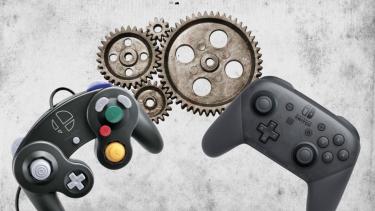
You won't wanna miss out on these adjustments...
Sometimes, the most simple adjustments can make your usual gameplay feel much easier and more natural. Or better yet, they can open the door to higher-level moves and combos that are usually impossible without an ungodly amount of practice. You’d be surprised how much of a difference these can make, and in this top 10 list, you’ll find at least a few things you never knew you needed.
10. Stick Jump Off
The Problem:
- As a standard, Stick Jump is on in Smash gameplay. What that means is that every time you flick the joy-stick up, your character will jump whether you wanted them to or not.
How Stick Jump Off Solves The Problem:
- You can do upwards attacks at any moment and move the stick around as you please without worrying about accidental jumps.
How to Apply Stick Jump Off:
- Go to the control icon at the bottom of screen in the Smash section.
- Select your name.
- Select the type of controller you have.
- Select Other Settings on the bottom left.
- Go to Stick Jump and switch it to Off.
9. Grab at Face Button
The Problem:
- Grab is usually set to one of the right shoulder buttons, which by itself isn't really a problem, however there are a good amount of players who prefer it to be a face button.
How Grab at Face Button Solves The Problem:
- You can have Grab outside the shoulder buttons, and be right next to your Attack and Special buttons, so moving between them with your thumb can be more natural.
How to Apply Grab at Face Button:
- Select the type of controller you have.
- Click either X or Y (your preference).
- Select Grab.
8. Grab at L (Gamecube Controller)
The Problem:
- Again, with the two shoulder buttons on the right, fidgeting between them for Grab and Shield can be annoying, which is why many players change that.
How Grab at L Solves The Problem:
- This way, you can leave each index finger placed on each shoulder button, one for Grab and one for Shield, so you can press whichever one you want depending on what you need, and not have to worry at all about moving these fingers.
How to Apply Grab at L:
- Select the Gamecube controller.
- Select L.
- Select Grab.
7. Jump at L
The Problem:
- Instead of Shield, you could use L for Jump. The problem is that if you have the Jump input on your face buttons only, as is normal, you can only jump with your right hand.
How Jump at L Solves The Problem:
- If you’ve ever in a situation in which your right hand is busy, you can buy yourself some time with a jump on your left trigger.
How to Apply Jump at L:
- Select the type of controller you have.
- Select L (or ZL if you want, for the pro).
- Select Jump.
6. Special at X (Gamecube Controller)
The Problem:
- There are many characters that benefit from jumping with Projectiles (think Pikachu and Mario). The problem is that with the Gamecube controller, both standard Jump buttons are far away from the Special button, that being B.
How Special at X Solves The Problem:
- Special at X has your Special button right next to your Jump button at Y. This way you can pretty much press them at the same time with your thumb and guarantee you are doing your jumping projectiles with perfect timing.
How to Apply Special at X:
- Select the Gamecube controller.
- Select X.
- Select Special.
5. Jump on All Shoulders
The Problem:
- In Smash, you have to mash buttons to try and get out of grabs or burrows. But mashing all buttons randomly can be kind of dangerous. You can end up pressing something resulting in a laggy move which will get you punished anyway, or send you flying offstage.
How Jump on All Shoulders Solves The Problem:
- The best way to mash depends on preference, but some may find that a fast way to do it is to use your index and middle fingers and mash all shoulder buttons. This works better on the Pro Controller because there are 4 buttons that are easier to press.
How to Apply Jump on All Shoulders:
- Select the type of controller you have.
- Select the shoulder buttons, and select Jump for all of them.
4. Mashing on D-pad
The Problem:
- Similar to before, mashing is a necessity, and you don’t want to get punished for mashing a bad airdodge or any laggy move.
How Mashing on D-pad Solves The Problem:
- Another option is to put Jump on all your D-pad buttons. This is a bit more convenient as it requires less adjustment. The D-pad buttons are saved for taunts, which are useless in combat.
- It also a better option for your Gamecube controller which only has 3 shoulder buttons.
How to Apply Mashing on D-pad:
- Select the type of controller you have.
- Select the D-pad buttons, and select Jump on all of them.
3. Tilt Stick
The Problem:
- Tilt Stick is one of the most common and useful controller settings used by pros, for the following reason. Tilts require you to gently move your controller stick in the direction you want, then press A. But the thing is that you do a Smash attack input by flicking the control stick hard, and pressing A, and in a fast-paced match, where you’re moving all around, this is easy to do accidentally.
How Tilt Stick Solves The Problem:
- Tilt Attack lets you do these quick turn-around tilts, or any tilt attack for that matter, easily and quickly, without having to worry about accidentally doing a laggy Smash attack.
How to Apply Tilt Stick:
- Select the type of controller you have.
- Select your Right Stick (C-Stick for Gamecube controller).
- Select Tilt Attack.
2. Special Stick
The Problem:
- Now we’re getting into some high-level stuff. If you were unaware, there’s this thing in Smash call B-reversing. Basically, if you’re jumping back you can instantly shift that same momentum forward, and vice versa, by doing a Special, and quickly flicking your left joy-stick in the opposite direction. It’s not too hard to do with Neutral B, but with a Side B, you have to basically flick your left stick in three different directions in the span of a second, making it near-impossible. And Side Bs often have good and useful projectiles you would want to use this for.
How Special Stick Solves The Problem:
- Your right stick can be changed to Special, and the direction you flick will be the type of Special move that comes out, facing that same way. This means you can flick it to do Side-B, and then quickly do the same with your left stick in the opposite direction and get the B-reverse. Might take some practice still, but this way, you’ll be shifting in the air with your projectiles, allowing for better combos and escape options.
How to Apply Special Stick:
- Select the type of controller you have.
- Select your Right Stick (C-Stick for Gamecube controller).
- Select Special.
1. Special at L
The Problem:
- Just as before, B-reversing with Side-B is difficult and this setting makes it easier as well. The reason it is ranked higher than the Special Stick, is that this one frees your right stick.
How Special at L Solves The Problem:
- How it works here is that you need to jump, press L for special, and immediately flick the right stick in the opposite direction. This works whether you have Smash Attack or Tilt Attack on (don’t ask me why). This way you can do your cool B-reverses to mix up your opponents, while still having your right stick available for attacks.
How to Apply Special at L:
- Select the type of controller you have.
- Select L (or ZL if you want, for the pro).
- Select Special.
You may also be interested in:
- Smash Bros Ultimate Guide for Beginners and Advanced Players
- Smash Ultimate Best Characters [Smash Ultimate Tier List]
- [Top 10] Smash Ultimate Best Spirits That Are OP
- [Top 10] Smash Ultimate Best Amiibo
- [Top 10] Smash Ultimate Best Air Game
- [Top 10] Smash Ultimate Best Aggressive Characters
- [Top 10] Smash Ultimate Best Beginner Fighters
- Top 10 Best Smash Ultimate Players
- Top 5 Smash Bros. Ultimate Tournaments in The World
- Smash Ultimate Tournaments List (All Major Tournaments To Watch)
- 10 Best Smash Ultimate Custom Stages
